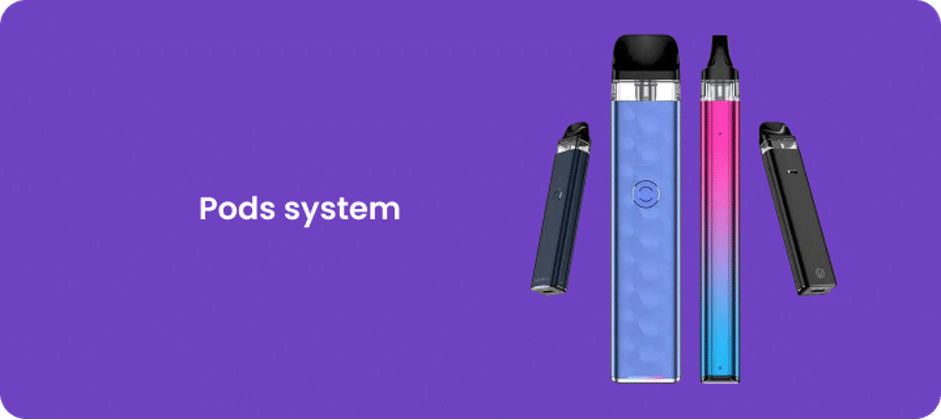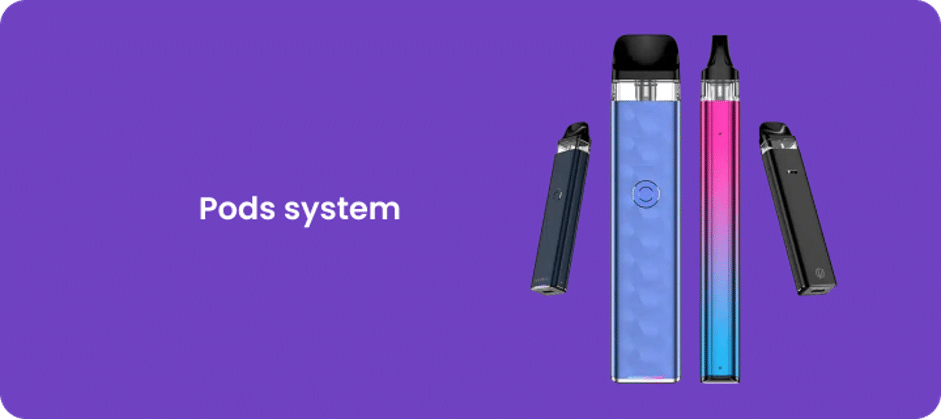The increasing popularity of vaping has resulted in a saturated market filled with devices catering to diverse needs and preferences. Among the most frequently utilised options are pod systems and vape pens, each offering distinctive features, portability, and user-friendliness. For individuals who are new to vaping or contemplating a transition in their devices, a pertinent question often arises: Which vape kit is better suited to their needs?
Both pod systems and vape pens represent viable choices for beginners and experienced vapers alike. However, they serve somewhat different functions. Vape pens are slender, pen-shaped devices characterised by their straightforward design and versatility. They typically include refillable tanks, adjustable settings, and compatibility with a broad spectrum of e-liquids.
Conversely, pod systems are compact, user-oriented devices that operate using pre-filled or refillable pods. These systems are designed to prioritise convenience and frequently provide a smoother nicotine intake, especially when utilising nicotine salts.
The selection between a pod system and a vape pen is contingent upon the user’s vaping style, nicotine preference, and the degree of control desired over the device. This guide aims to highlight the key differences along with the benefits and drawbacks of each option to assist users in determining which vape kit best aligns with their lifestyle. Whether the objective is to generate substantial vapour clouds, engage in discreet vaping, or pursue a hassle-free experience, this analysis seeks to offer comprehensive insights.
The decision between pod systems and vape pens primarily hinges on users’ vaping styles, nicotine preferences, and the degree of control they desire over their devices. A critical factor to consider is the type of e-liquid that users favour. For users who prefer nicotine salts, which provide a smoother throat hit and quicker nicotine absorption, pod systems are frequently the more advantageous option. These devices are specifically engineered to accommodate higher nicotine concentrations without resulting in harsh inhalation experiences. Conversely, vape pens are better suited for freebase nicotine e-liquids, offering a broader array of flavours and lower nicotine strengths. These are particularly appealing to users who prioritise flavour and vapour production.

Another vital consideration is vapour production. Vape pens generate more significant vapour clouds due to their powerful coils and adjustable airflow settings. They are ideal for users who engage in cloud chasing or prefer a more substantial vapour experience. In contrast, pod systems are designed for discreet vaping, resulting in minimal vapour output, which makes them suitable for individuals seeking a more inconspicuous, portable vaping experience.
Portability and convenience significantly influence the decision-making process. Pod systems are compact, lightweight, and exceedingly easy to transport, making them ideal for users who are frequently on the move. While vape pens are also portable, they tend to be bulkier because of their larger tanks and batteries. However, they often facilitate longer vaping sessions without the necessity for constant refilling or recharging.
Furthermore, ease of use and maintenance are crucial considerations. Pod systems are typically more user-friendly, requiring minimal setup and maintenance. Most systems utilise disposable or refillable pods that are simple to replace. In contrast, vape pens may necessitate more regular maintenance, such as coil replacements, tank refills, and setting adjustments. This aspect may appeal to users who appreciate greater control over their vaping experience.
Lastly, battery life and usage frequency are relevant factors. Vape pens are typically equipped with larger batteries, providing longer usage times for heavy vapers. Despite their smaller batteries, Pod systems can still accommodate moderate usage but may require more frequent charging if utilised extensively throughout the day.
Ultimately, choosing the right vape kit comes down to personal preferences, vaping habits, and the experience a user is aiming for. This guide explores the detailed benefits and drawbacks of pod systems and vape pens, enabling users to make informed decisions based on what matters most to them.
Pods system

Pod systems are e-cigarettes designed for simplicity and ease of use. They consist of two primary components: a battery and a pod that can either be replaced or refilled with e-liquid. These devices are compact, making them highly portable and discreet for users.
Vape pod represents an optimal choice for individuals seeking portability and a smooth transition from traditional smoking. Whether individuals are transitioning from cigarettes, upgrading from disposable devices, or in search of a sleek and convenient vaping solution for daily use, pod systems offer a user-friendly experience.
Users may select pre-filled closed pod systems, such as the Elf Bar ELFA Pro, which delivers a straightforward setup with replaceable pods. Alternatively, they might consider refillable pod systems, such as the vapours XROS 4 Mini or the OXVA Xlim SQ, designed to function effortlessly with preferred nicotine salt e-liquids or 50/50 blends.
Open-system vape pods are refillable, allowing users to explore a variety of e-liquid flavours and nicotine strengths. In contrast, pre-filled and ready-to-use closed-system vape pods offer a hassle-free vaping experience with no refilling or assembly required; users replace the pod when it is empty.
Pod systems are an advancement over disposable vapes. Refillable pod vape systems provide users greater control, as they can be recharged and refilled with our extensive selection of
e-liquid flavours, ensuring that something satisfies every preference. Prefilled pod vape systems are also rechargeable, allowing users to easily replace the used pod with a new compatible
pre-filled vape pod refill when the e-liquid is depleted. We provide various refillable and pre-filled pod systems to meet diverse needs.
Benefits of pod systems
One of the most appealing features of pod systems is their user-friendly design. Most modern pod systems employ draw-activated firing mechanisms, enabling users to activate the device simply by inhaling—eliminating the need for buttons, wattage adjustments, or complex settings.
This simplicity makes pod systems an ideal choice for beginners transitioning from traditional smoking or for individuals who value a hassle-free vaping experience. Refillable pod systems are designed with straightforward filling ports, facilitating easy refilling without mess or technical knowledge. For users seeking a quick, efficient, and satisfying nicotine fix, pod systems deliver precisely that.
Pod systems are designed for portability, making them suitable for individuals with busy lifestyles or those who are frequently on the move. Their small and lightweight construction allows them to fit easily into pockets, purses, or even the palm of one’s hand. Unlike bulkier vape pens or mods, pod systems are discreet and travel-friendly, making them preferred for commuters, social events, or casual outings where carrying larger devices may be impractical.
Another significant advantage of pod systems is the wide variety of flavours and nicotine strengths, particularly with the increasing popularity of nicotine salt e-liquids. Pre-filled pods come in diverse flavour options, from classic tobacco and menthol to fruity and dessert profiles. Refillable pod systems allow users to experiment with many e-liquid brands and blends.
Moreover, the ability to choose different nicotine levels—including high-nicotine salts—makes pods particularly appealing for smokers seeking to manage or gradually reduce their nicotine intake.
Pod systems are often favoured for their low maintenance requirements. Pre-filled pods offer maximum convenience; users discard and replace the pod once emptied, eliminating the need for cleaning, coil changes, or messy refills. Refillable pods are designed to minimise maintenance, requiring only occasional cleaning and straightforward refilling. This makes pod systems ideal for vapers who prefer minimal upkeep or wish to avoid the hassle of regular coil replacements.
Pod systems excel in these aspects for users who prioritise privacy and discretion. Their compact design and lower vapour production enable users to vape without attracting significant attention, making them suitable for indoor use, social gatherings, or public settings where large vapour clouds may be inappropriate. As such, pod systems are well-suited for professionals, students, or anyone seeking to maintain a discreet vaping experience while adequately satisfying their nicotine cravings.
Drawbacks of pod systems
One of the most significant drawbacks of pod systems is their limited battery capacity, which results from their compact and lightweight design. While portability is an advantage, it often means that most pod systems are equipped with smaller internal batteries that may not last an entire day for moderate or heavy vapers. This can lead to frequent recharging, which may be inconvenient for users who spend long hours away from a charger, such as commuters or individuals with busy schedules. Devices like the JUUL and other ultra-compact pods are well-known for this limitation, making battery life an essential factor to consider.
While refillable pod systems can save money in the long run by allowing bulk e-liquid purchases, several cost factors remain to consider. The initial investment in a quality pod system can be higher than expected, especially considering the need for replacement coils or pods over time. For users of pre-filled pods, the cost of each pod can accumulate quickly, often making it more expensive than refillable systems or even vape pens in the long term. Replacement pods—especially proprietary ones—tend to be priced higher, contributing to the overall expense.
Pre-filled disposable pods contribute significantly to environmental waste. Each used pod containing plastic and electronic components are discarded once empty, leading to a substantial volume of non-recyclable waste. Given the growing emphasis on environmental impact in the UK and worldwide, this is a valid concern for eco-conscious vapers. While refillable pods offer a more sustainable option by reducing single-use waste, many users still opt for disposables’ convenience, exacerbating pod systems’ environmental footprint.
Pod systems generally offer minimal customisation options, unlike more advanced vape pens or box mods. Most pods come with fixed power outputs, non-adjustable airflow, and set resistance, preventing users from making adjustments to enhance their vaping experience. This could be a disadvantage for experienced vapers who enjoy tweaking settings to improve flavour, vapour production, or throat hit. With pod systems, what is visible is mostly what is obtained, which may not satisfy users seeking greater control and personalisation in their vaping.
Another downside is the limited pod compatibility, especially with closed pod systems. Many brands design their pods to be proprietary, meaning users must only purchase that brand’s pre-filled pods or replacements. This restricts the freedom of choice regarding flavours, nicotine strengths, or e-liquid types. For instance, users of specific popular pod systems cannot refill or use third-party pods, forcing them into a closed ecosystem that may lead to higher costs and fewer options. While refillable pod systems somewhat alleviate this issue, it is essential to note that not all devices support every e-liquid on the market, particularly high-VG juices that some pods cannot handle well.
VAPE PENS

A vapouriser pen, commonly called a vape pen, is one of the most popular types of e-cigarettes available today. A vape pen is available in various shapes and sizes; however, all models share similar components. The two primary features consist of a cartridge designed to contain oil or concentrates and a power source (battery) that heats the cartridge to generate vapour. Initially, vape pens were mass-produced for the e-cigarette market, but recent advancements have led to their re-engineering specifically for high-viscosity extracts. All vape pens in our collection are rechargeable and refillable, allowing users the flexibility to select from our extensive range of e-liquids and nicotine salts.
Vape pens have become a favoured option for users seeking to transition away from disposable devices. Their pen-shaped design resembles single-use products, such as the Elf Bar 600, providing a comparable vaping experience at a reduced cost and an expanded selection of flavours.
Each vape pen offered, including the Skope Air and Joyetech eRoll Slim, is categorised as a mouth-to-lung (MTL) vape pen. These devices deliver a vaping style similar to disposables, as they are puff-activated and are regarded as among the most user-friendly vape systems available, particularly for novices. For users desiring a vape pen with extended battery life, the Tornado GTL is distinguished by its longevity and the option for customisable coil and airflow settings, allowing individuals to personalise their vaping experience to meet specific preferences.
Benefits of vape pen
Vape pens are among the most popular devices due to their practical design, affordability, and balanced performance. One significant advantage for the vaping community is their
cost-effectiveness, especially compared to the rising trend of disposable vapes. With increasing living costs, many users seek devices that offer good value for money, and ideally, vape pens meet this need. Their refillable tanks and replaceable coils help lower long-term costs, making them a wiser investment for regular users than the ongoing expense of purchasing disposables.
Another key advantage is the compatibility with TPD-compliant e-liquids. Vape pens support the use of 10ml bottles, which is the legal limit under the Tobacco Products Directive (TPD). This
compatibility allows users to explore various flavours, nicotine strengths, and e-liquid types, including freebase and nicotine salts. Devices like the Aspire PockeX AIO and Innokin Endura T20-S are excellent examples of vape pens designed following regulations while delivering outstanding flavour and performance.
Portability and convenience also make vape pens ideal for the busy, on-the-go population.
Lightweight and pocket-friendly, they are perfect for commuting, work breaks, or social gatherings. Devices such as the GeekVape Wenax S3 and vapouresso GTX Go 80 offer solid battery life, allowing users to vape throughout the day without needing constant recharging—a crucial factor for individuals who spend long hours away from home.
Vape pens deliver superior vapour production and flavour quality compared to pod systems and disposable vapes For users seeking a satisfying vaping experience. Models like the SMOK Vape Pen V2 are designed with more powerful coils, enabling users to enjoy denser clouds and richer flavours. This feature is especially appreciated by former smokers looking for a stronger throat hit or a more immersive vaping experience.
Vape pens strike an ideal balance between simplicity and performance. Most devices are user-friendly, making them accessible to beginners while offering enough customisation options—such as adjustable airflow or wattage—to appeal to more experienced users. This versatility makes vape pens suitable for a wide range of individuals, from first-time vapers trying to quit smoking to experienced enthusiasts seeking a reliable everyday device.
Drawbacks of vape pens
While vape pens present numerous advantages, they also entail certain disadvantages that users should consider before designating them as their primary vaping device. One prevalent issue is their larger size than pod systems or disposable vapes. For users who prioritise portability or seek a discreet device for quick use in public settings, vape pens may be bulky, particularly models equipped with larger tanks and batteries, such as the SMOK Vape Pen V2. Their dimensions may not accommodate small pockets or handbags comfortably, creating potential inconvenience for commuters or individuals who are frequently on the move.
Another notable drawback is the increased maintenance required. In contrast to disposable vapes, which can be used and discarded, vape pens necessitate regular upkeep. This includes refilling the tank, replacing coils, and cleaning the device to mitigate leaks or unpleasant tastes.
This additional maintenance may appear daunting for beginners or individuals with busy schedules. Additionally, a failure to promptly replace the coil can adversely affect flavour quality and vapour production, leading to frustration among novice users.
Furthermore, due to their powerful coils and excellent vapour production capabilities, vape pens tend to consume more e-liquid. While this enhances the vaping experience regarding flavour and cloud size, it results in more frequent refills and elevated ongoing costs for e-liquid, which may concern budget-conscious users. Given that e-liquid prices vary significantly, some users may find vape pens less economical over time, mainly if they vape heavily.
Advanced vape pen models include adjustable settings such as wattage control and airflow. While these features may appeal to experienced users, they can confuse beginners. Improperly adjusted settings may result in suboptimal vapour production or burnt coils, thus compounding the learning curve for users transitioning from traditional smoking or disposable devices.
Final thoughts
When deciding between a vape pen and a pod system, the choice ultimately comes down to personal preference and the most important features to users. Users should choose pod systems for convenience and opt for vape pens if they seek enhanced performance.
Vape pens offer greater versatility, power, and customisation options, making them preferable for users who desire stronger flavour, more significant vapour clouds, and longer battery life.
However, they do require more maintenance. Conversely, pod systems excel in ease of use and convenience, making them ideal for beginners or casual vapers who prioritise simplicity, portability, and discreet vaping. The trade-off is that these systems typically have limited battery life and fewer customisation options.
